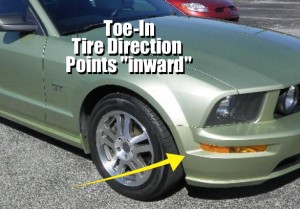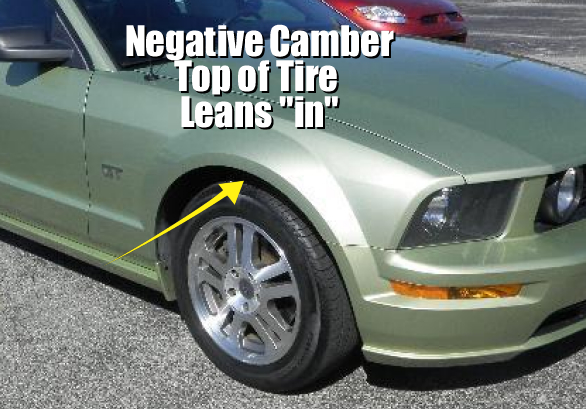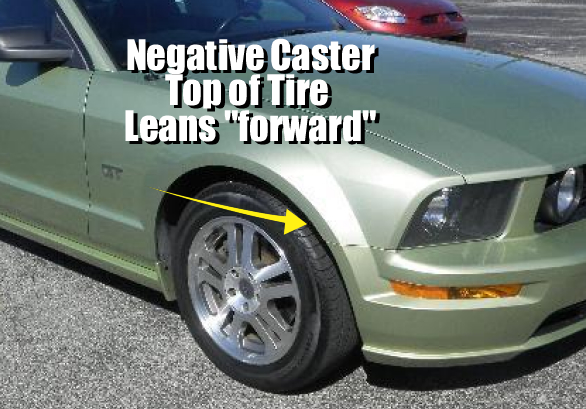Car Wheel Alignment Basics – Toe, Camber & Caster Explained
March 22, 2012 5:32 pm Alignment© DenLorsTools.com Summary: A short article by a certified master technician which explains in easy to understand terms, what basic car alignment angles consist of. Questions answered like “Which angles cause the most wear?” “What causes my car to pull?” and more. See what shopping carts and your shoes have in common with your car pulling and tires wearing.
First a little about my experience. I started doing car alignments back in the 1980’s at a Goodyear store in Dade City Florida. It used to be called West Coast Tire and then was later renamed Thornhill Tires after one of the owners. We had an old style alignment pit. Ramps basically extended over a hole/pit in the concrete floor – a similar set-up as quick lube oil change places have today. We were using an old John Bean alignment system that I suppose was made in the 1960’s. It had mirrored heads that attached to the front wheels. A device on tracks on either side of the front wheels projected a beam of light on the mirrored heads.
The light then was projected up on a white screen in front of the car with a graph. Obviously this was way before computers and there weren’t that many front wheel drive cars. In fact the first front wheel drive cars we aligned, we had to back the cars on the ramps over the pit. We would align the rear first – taking into consideration that the toe angles would be opposite for the toe reading. And then turn the car around to align the front. This was a work-around to continue using the old equipment – what a pain!
Below are the three main angles. There are other more technical angles that we could cover. However, the alignment angles below are the primary ones that most alignment technicians deal with everyday.
Toe Angle – Which angle causes the most tire wear?
Toe is the direction that the tires are pointed. The “toe” angle is typically the angle that can wear the vehicles tires the fastest. Think of your feet. If your toes are pointed outward when walking, your shoes will wear unevenly with most of the wear occurring on the inside of your souls. Point your toes inward while you walk and the wear will predominantly be on the outside edge of your shoes. So, if your cars tires are toed (or pointed) in – the wear will be on the outside edge. Tires toed  (or pointed) out – the wear will be on the inside edge. If the toe angle is extremely off, the immediate result could be described as a “wander” while driving followed by rapid tire wear.
Camber – Why does my tire lean in?
Camber is basically the tilt of the top of the tire. If the tire is tilted outward – away from the car this is called positive camber. Likewise, if the top of the tire is tilted inward – towards the car this is called negative camber. Out of specification, camber will cause tire wear. However the wear is much more gradual when compared to “toe” wear. If the camber measurements vary too much from side to side the car may drift (have a slight pull) to one side or the other. The more the camber difference is, the stronger the pull. It’s important to know that a “zero reading (a tire that is perfectly straight up and down) is hardly ever desirable. Specifications usually allow for some negative (tire leaning in) for increased stability and handling.
Caster – What causes my car to pull?
Caster is an angle that does NOT cause tire wear. It can however cause the car to pull. Usually if the caster varies too much from side to side a very noticeable pull can be felt when driving. The caster angle is actually the tilt of the tire frontward or backward. Example – If the tire on the left front has a lower reading (we’ll say 1 degree) when compared to the right front (we’ll say 3 degrees) the car will pull to the LEFT. Basically the car will pull to the negative side.
Tire Pull
It’s important to know that tires commonly cause a pull. The alignment may be optimal and the car may have a pull. Tires are so common when it comes to making a car pull that even the technician may not be able to tell by driving which is causing it. MOST of the time a tire pull can be detected if the car pulls at very slow speeds. Usually if the car only pulls at higher speeds it can be attributed to an alignment issue. One quick easy way to determine if the tires are causing a pull is to swap the front two. Most of the time when the left front and the right front are switched and the pull goes away or the car pulls the opposite direction the tires can be blamed. Even brand new tires can cause a pull. The cheaper the tires the more likely there could be a problem like this.
Brake Pull
If there’s a pull when driving until the brakes are applied and then the car pulls to the opposite side, one of the calipers or brake hoses could be at fault. If one of the calipers is “hanging” or sticking for some reason the car may have a pull. When the brake pedal is applied the other caliper grabs causing the car to veer back to the other direction.
Thanks for reading, please check out our main website for your automotive tool needs.



